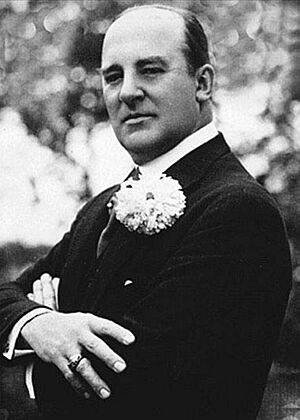Cesáreo Bernaldo de Quirós facts for kids
Cesáreo Bernaldo de Quirós (born May 27, 1879 – died May 29, 1968) was an important Argentine painter. He was part of the post-impressionist art movement, which means his paintings often used bold colors and visible brushstrokes to show feelings and light, rather than focusing on perfect realism.
Contents
A Young Artist's Journey
Early Life and First Paintings
Cesáreo de Quirós was born in Gualeguay, a town in Entre Ríos Province, Argentina, in 1879. He started painting when he was only eight years old! Once, he even drew a picture of a criminal's face that helped the police catch the person.
Cesáreo wasn't always the best student in school. He often skipped classes to spend time with the gauchos, who are skilled horsemen and cowboys of the Argentine plains. During one of these times, he saw a duel (a fight between two people). This event inspired him to create his very first known painting.
Learning to Paint in Buenos Aires
His father, who was from Spain, was worried about Cesáreo's school attendance. After his mother passed away in 1895, his father sent him to a Buenos Aires boarding school. There, Cesáreo met a Spanish painter named Vicente Cotanda, who gave him his first real art lessons.
Later, Cesáreo was accepted into the Fine Arts Academy. He learned from famous realist painters like Ángel Della Valle and Ernesto de la Cárcova. In 1898, he was offered a scholarship to study art in Rome, Italy. However, his father didn't think he had earned such a big honor yet, so the scholarship was canceled.
Studying and Traveling in Europe
But Cesáreo didn't give up! In 1899, he won the Rome Prize from the Spanish Royal San Fernando Fine Arts Academy. This prize allowed him to study in Rome for three years. After that, he moved to Mallorca, a beautiful island in Spain, and lived there until 1910.
During this time, he made short trips to other places. He visited Rome for the 1905 World's Fair and went to the Venice Biennale, a famous art exhibition. He also visited Buenos Aires, where he showed his art with other painters like Pío Collivadino and Fernando Fader. In 1906, these artists formed a group called the Nexus Group. They helped make post-impressionism popular in Argentina. While in Europe, Cesáreo met María Antonelli, and they later had two children together.
Returning to Argentina and Success
In 1910, Cesáreo briefly returned to Argentina for the Centennial Exposition. He showed 26 of his paintings and won a Gold Medal for his work called Horse Race for the Ring on Independence Day. This painting was inspired by his childhood memories of gauchos and their traditional games. The new Provincial Fine Arts Museum in Paraná bought this painting.
As he became more famous, he bought a villa in Settignano, Italy, and an apartment in Paris, France. He often welcomed other Argentine artists who were living in Paris.
The Gaucho Painter
Back Home and New Inspiration
In 1914, his father passed away, and World War I began. These events led Cesáreo to move back to his family home in Gualeguay, Argentina. The President at the time, Victorino de la Plaza, was a big supporter of the arts. In 1915, he added 72 of Cesáreo's paintings to the National Fine Arts Commission's collection.
Cesáreo continued to be successful in Argentina, Chile, and Uruguay. This success allowed him to buy a large art studio in Buenos Aires, facing the beautiful Palermo Rose Garden.
The Gaucho Series
In 1923, Cesáreo moved to a quiet country estate, called an estancia, in Entre Ríos Province. This historic property had once belonged to the daughter of a former president. The beautiful surroundings became the perfect setting for his most famous series of paintings, called "the gauchos." These were naturalist paintings, meaning they showed things as they really looked. He exhibited and sold these works all over the world. Sadly, during this time, he lost his daughter Carlota.
In 1938, he bought another large estancia near Paraná. He then started to focus more on landscape art, painting beautiful scenes of nature. In 1939, the National Fine Arts Museum in Buenos Aires showed and bought many of his works. Leopoldo Lugones, a very famous Argentine poet, even called de Quirós "our national painter."
Later Life and Legacy
In 1947, the artist moved to a horse-riding estate in Vicente López, a fancy suburb of Buenos Aires. One of his close friends and neighbors there was Florencio Molina Campos, another important Argentine artist known for his naïve art (a simple, direct style of painting).
Cesáreo won a Grand Prize at the Madrid Biennale in 1951. In 1960, he married Yole Lanzelotti, who was a singer. In 1965, the National Fine Arts Museum bought thirty paintings from his "the gauchos" series. In 1967, his home province gave him their Legion of Merit award, a great honor.
Cesáreo Bernaldo de Quirós passed away in his Vicente López home on May 29, 1968, two days after his 89th birthday. Although a special building for his art at the National Fine Arts Museum was never built, the Pedro E. Martínez Provincial Fine Arts Museum in Paraná created the Salón Quirós. This room holds the largest collection of his works. Another important collection of his art can be found at the Tigre Art Museum near Vicente López.
See also
 In Spanish: Cesáreo Bernaldo de Quirós para niños
In Spanish: Cesáreo Bernaldo de Quirós para niños


